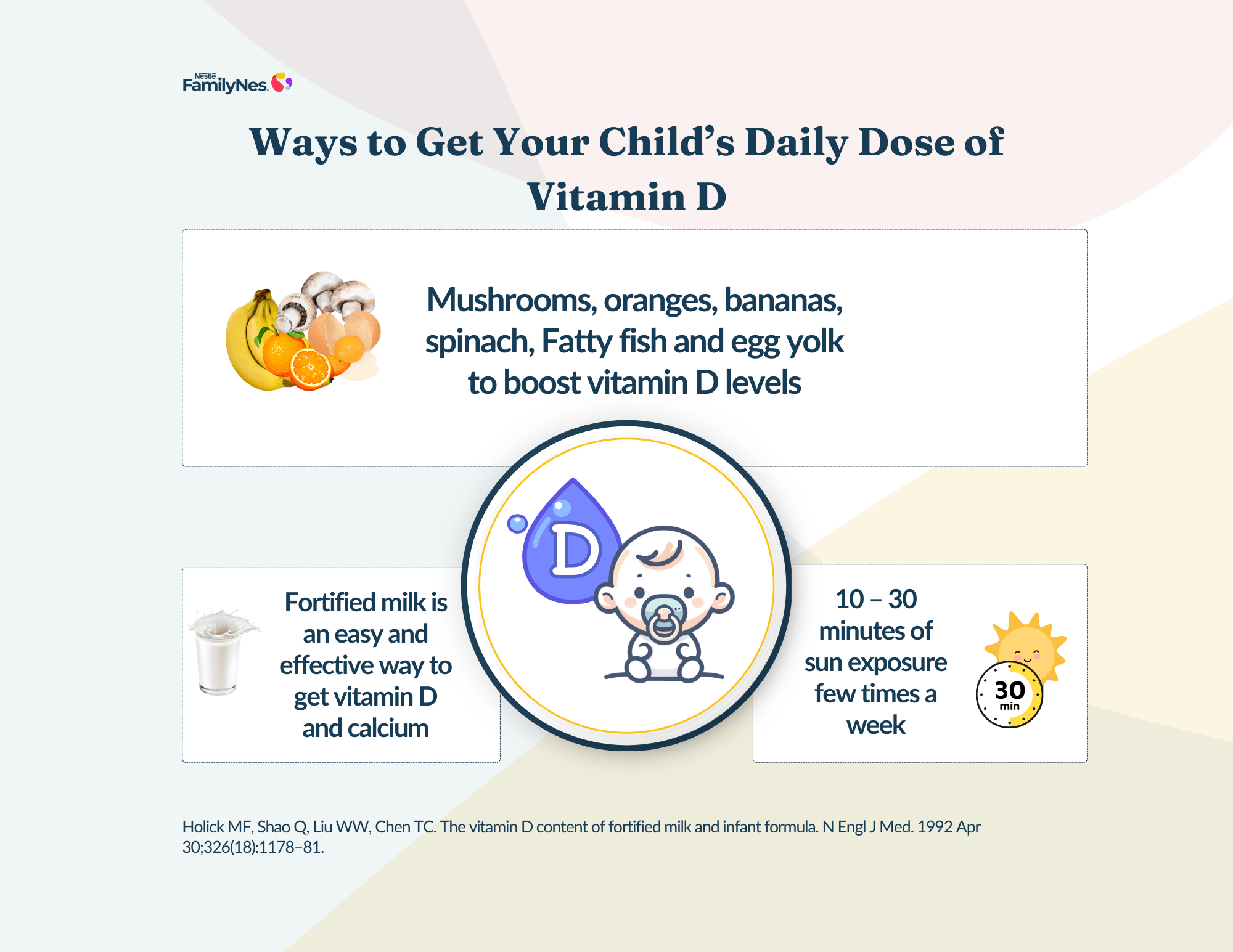
Why Vitamin D is Vital for Supporting Bone Growth in Children?
Are you sure your child is getting enough vitamin D to support bone growth and development?
The body is dependent on bones for several of its vital functions, such as movement, protecting internal organs like the heart and lungs, and serving as a storage site for minerals. Building strong bones during childhood lays the foundation for lifelong bone health. Most of our bone density develops during our early years and adolescence. The mineralization of bone structures in early childhood lasts a lifetime and defines the bone mass of adulthood. The process of bone growth & development involves the elongation of bones in growth plates, which eventually become hard and assist in their height while the bones increase in thickness as new tissues are added on the exterior. This growth is dependent on a balanced diet with vital bone-forming nutrients such as calcium, vitamin D, and phosphorus.(1)
Why is Vitamin D Important in the Bone Growth of Kids?
Vitamin D plays a crucial role in bone health by helping the body absorb and retain calcium and phosphorus, key minerals needed to build strong bones. Severe deficiency of vitamin D leads to rickets, a condition that weakens bones and bow-shaped bones and can affect young children, particularly in the early years of life. A lack of vitamin D also raises the risk of fractures in older children. Vitamin D is also important in supporting the body’s immune system, helping the body fight off common infections and other disease-causing microorganisms.
Kids can get vitamin D through sun exposure, dietary sources, and supplementation when necessary. Adequate vitamin D consumption will allow them to develop strong, healthy bones.
Do you know? Vitamin D helps with calcium absorption.
Calcium is actively absorbed from the small intestine in the presence of vitamin D. Together with phosphorus, it forms hydroxyapatite crystals to mineralize and strengthen bones. Thus, an optimal intake of vitamin D and calcium is crucial for proper bone mineralization.(1)
Ways to Get Your Child’s Daily Dose of Vitamin D

1. Sun Exposure: The Natural Vitamin D Solution
Sunlight is the most natural source of vitamin D and is readily available to those who spend time in the sun. The body naturally synthesizes it after 10 – 30 minutes of sun exposure a few times a week. Depending on factors such as skin color, locality, and season, individuals may require different amounts of exposure to the sun.
2. Vitamin D-rich foods
There are many foods that the child can eat to obtain vitamin D, such as mushrooms, oranges, bananas, spinach, fatty fish, and egg yolk. Adequate inclusion of these foods in appropriate quantities can support the child’s bone development
3. Fortified milk as a supplement
One of the simplest and most effective methods to guarantee that your child gets the necessary vitamin D is through fortified milk, which contains vitamin D and calcium to promote bone growth and development. Such milk beverages can be incorporated into your child’s daily diet to obtain adequate vitamin D. Fortified Oat, almond, and soy milk can make a good option for lactose-intolerant kids. Breakfast cereals and yogurt fortified with vitamin D are other suitable alternatives. (2)However, consulting with your healthcare provider is always recommended to make better decisions.
Vitamin D Doses: How Much is Enough?
- Infants: 400 IU daily.
- Older children and adolescents: 400 - 600 IU daily.
This amount of vitamin D should be met through diet and natural resources like sunlight, as it helps keep bones strong and supports overall health.(3)
Tips for Parents:
- Include vitamin D-fortified milk in your child's diet.
- Read food labels to ensure products contain optimal vitamin D.
- You can also combine fortified foods with calcium rich foods or beverages for better and healthy vitamin D absorption.
Ensuring your toddler receives enough vitamin D is essential for strong bones. Since vitamin deficiencies, particularly vitamin D, are common, incorporating vitamin D-rich foods, ensuring sufficient sun exposure, adding milk fortifiers containing vitamin D, and encouraging regular physical activity can significantly support healthy bone growth. By prioritizing these factors, you help lay the foundation for your child’s lifelong bone health, allowing them to grow, develop, and thrive. We’d love to hear from you!
How do you know your child is getting enough vitamin D? Share your advice or ask any questions in the comments below. Let's keep the discussion going and help each other raise healthy, happy kids.
References
- Agostini D, Donati Zeppa S. Vitamin D, Diet and Musculoskeletal Health. Nutrients. 2023 Jun 27;15(13):2902.
- Holick MF, Shao Q, Liu WW, Chen TC. The vitamin D content of fortified milk and infant formula. N Engl J Med. 1992 Apr 30;326(18):1178–81.
- Gupta, P., Dabas, A., Seth, A. et al. Indian Academy of Pediatrics Revised (2021) Guidelines on Prevention and Treatment of Vitamin D Deficiency and Rickets. Indian Pediatr 59, 142–158 (2022). https://doi.org/10.1007/s13312-022-2448-y
Other Related Topics


